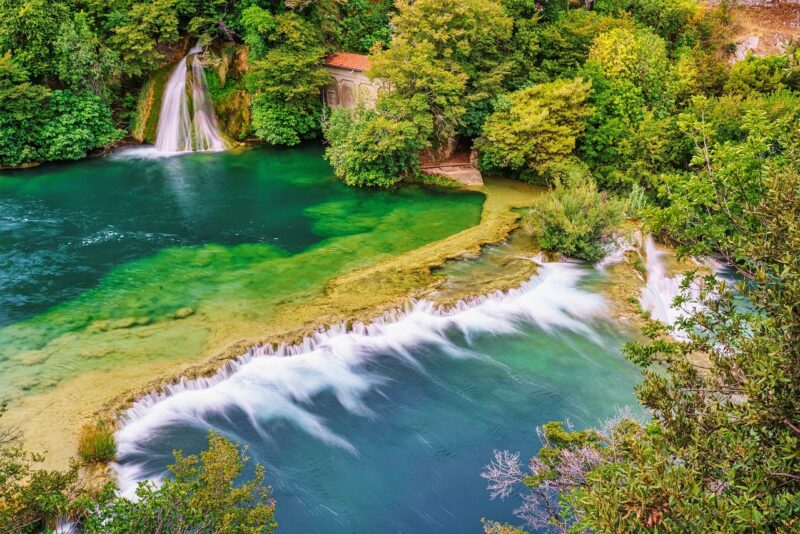Green Tourism in Croatia: Croatia is a stunning country located in Southeast Europe, known for its beautiful coastlines, historic cities, and lush green landscapes. Over the years, the country has become increasingly popular as a tourist destination, and green tourism has played a significant role in its growth. Green tourism, also known as eco-tourism, focuses on responsible travel practices that aim to minimize the impact on the environment while promoting conservation efforts. In this article, we will explore some of the best green tourism spots in Croatia.
Plitvice Lakes National Park
Overview
Plitvice Lakes National Park is one of the most famous and visited national parks in Croatia. It is known for its stunning cascading lakes, waterfalls, and lush greenery. The park is a UNESCO World Heritage Site and covers an area of 295 square kilometers. The park is home to a diverse range of flora and fauna, making it a haven for nature enthusiasts.
Activities
Visitors to Plitvice Lakes National Park can enjoy a range of activities, including hiking, bird-watching, and photography. The park has several well-marked trails that take you through the stunning landscapes, allowing you to experience the beauty of the park up close. Additionally, the park offers boat tours, which provide a unique perspective of the lakes and waterfalls.
Tips for Visitors
When visiting Plitvice Lakes National Park, it is important to be mindful of the environment. Stick to designated trails, avoid littering, and refrain from feeding the wildlife. The park can get crowded during peak seasons, so it is advisable to visit during the shoulder seasons to avoid the crowds.
Krka National Park
Overview
Krka National Park is another beautiful national park in Croatia, located near the town of Sibenik. The park is known for its stunning waterfalls, including the famous Skradinski Buk waterfall. The park covers an area of 109 square kilometers and is home to a rich biodiversity, including several species of birds and fish.
Activities
Visitors to Krka National Park can enjoy a range of activities, including swimming, hiking, and boat tours. The park has several designated swimming areas where visitors can take a dip in the refreshing waters. Additionally, the park offers guided tours, which provide insights into the history and ecology of the park.
Tips for Visitors
When visiting Krka National Park, it is important to respect the environment and follow the park’s guidelines. Swimming is only allowed in designated areas, and it is important to avoid disturbing the wildlife. The park can get crowded during peak seasons, so it is advisable to visit during the shoulder seasons to avoid the crowds.
Paklenica National Park
Overview
Paklenica National Park is located in the southern part of the Velebit mountain range, near the town of Starigrad. The park is known for its stunning canyons, caves, and cliffs, making it a popular destination for rock climbers and hikers. The park covers an area of 95 square kilometers and is home to a diverse range of flora and fauna.
Activities
Visitors to Paklenica National Park can enjoy a range of activities, including rock climbing, hiking, and spelunking. The park has several climbing routes that cater to different skill levels, from beginners to experienced climbers. Additionally, the park offers guided tours of the caves, providing insights into the geology and history of the area.
Tips for Visitors
When visiting Paklenica National Park, it is important to be prepared for the rugged terrain. Wear appropriate footwear, carry plenty of water, and be mindful of the weather conditions. The park can get crowded during peak seasons, so it is advisable to visit during the shoulder seasons to avoid the crowds.
Mljet National Park
Overview
Mljet National Park is located on the island of Mljet, in the southern part of Croatia. The park is known for its stunning saltwater lakes, dense forests, and historic monasteries. The park covers an area of 54 square kilometers and is home to a rich biodiversity, including several species of birds and fish.
Activities
Visitors to Mljet National Park can enjoy a range of activities, including swimming, cycling, and kayaking. The park has several designated swimming areas where visitors can take a dip in the refreshing waters. Additionally, the park offers bike rentals, allowing visitors to explore the park at their own pace.
Tips for Visitors
When visiting Mljet National Park, it is important to respect the environment and follow the park’s guidelines. Swimming is only allowed in designated areas, and it is important to avoid disturbing the wildlife. The park can get crowded during peak seasons, so it is advisable to visit during the shoulder seasons to avoid the crowds.
Brijuni National Park
Overview
Brijuni National Park is located on the Brijuni Islands, in the northern part of the Adriatic Sea. The park is known for its stunning landscapes, historic sites, and rich biodiversity. The park covers an area of 34 square kilometers and is home to a diverse range of flora and fauna, including several species of birds and fish.
Activities
Visitors to Brijuni National Park can enjoy a range of activities, including golfing, cycling, and boat tours. The park has a golf course that is open to the public, providing a unique golfing experience. Additionally, the park offers guided tours, which provide insights into the history and ecology of the park.
Tips for Visitors
When visiting Brijuni National Park, it is important to respect the environment and follow the park’s guidelines. The park is a car-free zone, so it is important to use bicycles or electric vehicles to get around. The park can get crowded during peak seasons, so it is advisable to visit during the shoulder seasons to avoid the crowds.
Conclusion
Green Tourism in Croatia: Croatia is a beautiful country with a rich natural heritage. The country’s national parks offer a unique opportunity to experience the stunning landscapes and rich biodiversity of the region. Whether you are a nature enthusiast, an adventure seeker, or simply looking to relax and unwind, Croatia’s green tourism spots have something for everyone. So, pack your bags, and get ready to explore the natural wonders of Croatia!
Similar Articles
FAQs About Green Tourism in Croatia
What is the best time to visit Croatia’s national parks?
The best time to visit Croatia’s national parks is during the shoulder seasons, which are the spring (April to June) and fall (September to October). During these times, the weather is mild, and the parks are less crowded, providing a more enjoyable experience.
Are there any restrictions on activities in the national parks?
Yes, there are restrictions on activities in the national parks to protect the environment and wildlife. Swimming is only allowed in designated areas, and visitors are encouraged to stick to designated trails and avoid disturbing the wildlife.
Are the national parks in Croatia suitable for families?
Yes, the national parks in Croatia are suitable for families. The parks offer a range of activities that are suitable for visitors of all ages, and there are facilities and amenities available to cater to the needs of families.
Do I need to book tickets in advance to visit the national parks?
It is advisable to book tickets in advance, especially during peak seasons, as the parks can get crowded. Booking tickets in advance ensures that you have a spot and can avoid long queues at the entrance.
What should I bring when visiting the national parks in Croatia?
When visiting the national parks in Croatia, it is important to bring appropriate clothing and footwear, plenty of water, sunscreen, and a hat. Additionally, it is advisable to bring a camera to capture the stunning landscapes.










